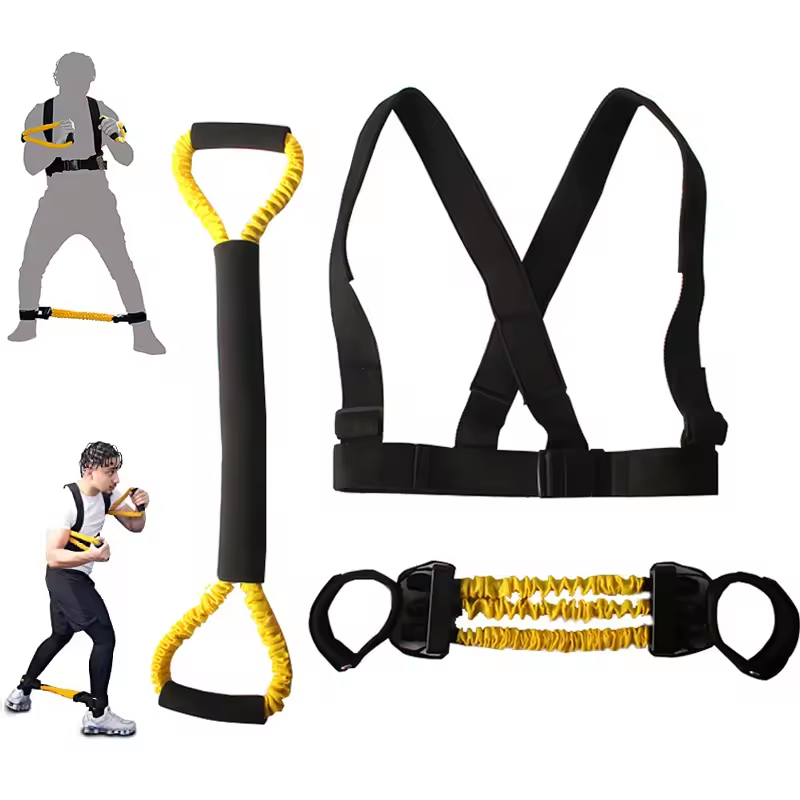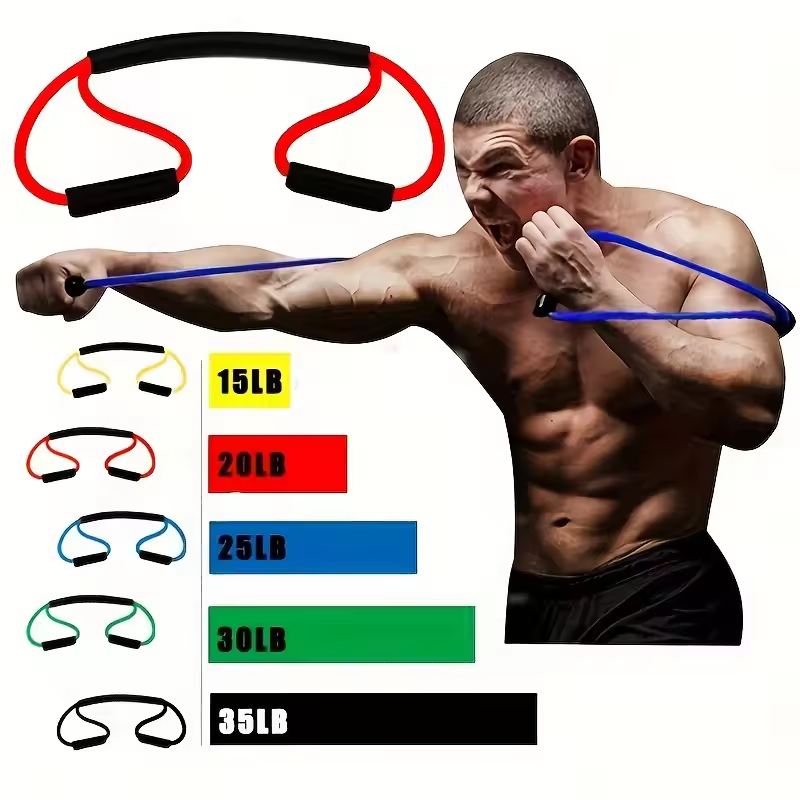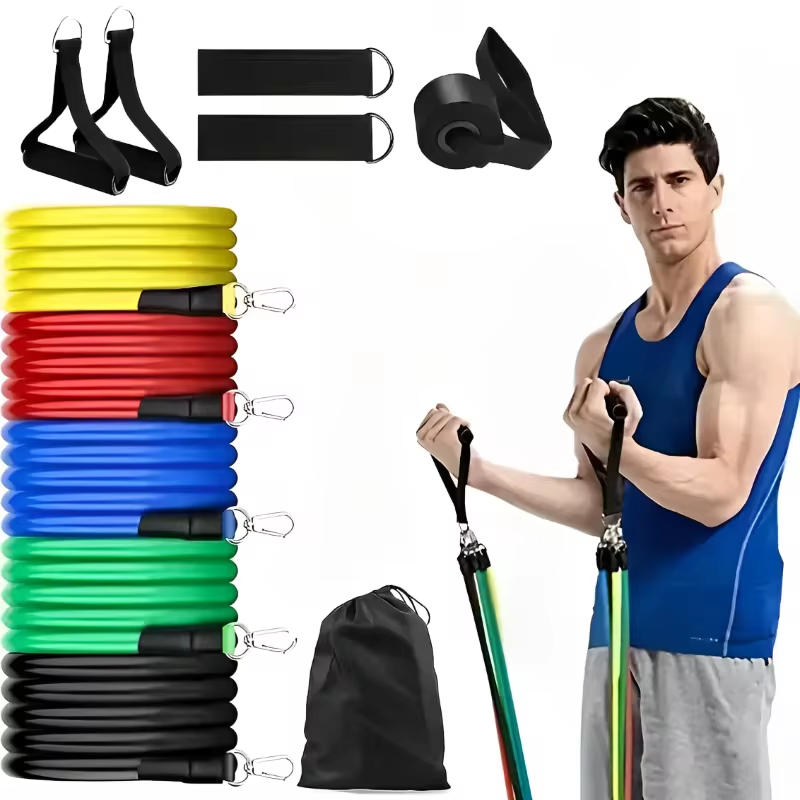The Benefits of Incorporating Resistance Bands into Boxing Training
Boxing resistance bands offer unique advantages for boxers. Here’s why they’re a knockout for your training regime:

- Increased Muscle Activation: Unlike static weight equipment, bands provide constant tension. This ups the muscle work throughout each movement.
- Enhanced Strength and Endurance: Resistance bands help in developing both strength and endurance. Boxers feel power surges in their strikes.
- Improved Coordination and Balance: Maneuvering against band tension demands high coordination. It sharpens balance, especially during complex combos.
- Full-Range Motion: Bands allow boxers to work through a full range of motion. This aids in flexibility and joint health.
- Customizable Resistance: Easy to switch bands for varied resistance. Tailor workouts to current fitness levels.
- Versatility and Portability: Bands are lightweight and portable. Train anywhere, from the gym to the park.
- Cost-Effective: They are an affordable addition to a boxer’s arsenal. You don’t break the bank to build muscle.
Incorporating boxing resistance bands into training routines is a smart move. Boxers can expect to see noticeable gains in many aspects of their fitness and technique.
Essential Resistance Band Exercises for Boxers
Boxers aiming to get the most from boxing resistance bands should focus on key exercises. Here are essential workouts to include:
- Shadow Boxing with Bands: Fix bands to a stationary object. Strap the other ends around your wrists. Throw punches to build shoulder and arm strength.
- Resistance Band Hooks and Uppercuts: Practice hooks and uppercuts against band tension. This hones power in your arm muscles and core.
- Band-Assisted Footwork Drills: Attach bands to your waist and move in boxing stances. Enhance agility and leg strength as you navigate the tension.
- Banded Bobbing and Weaving: Secure a band at head height. Practice bobbing and weaving. This improves your head movement and reaction time.
- Resistance Band Power Punches: Perform straight punches with bands. Feel the extra force required. It helps increase punching power.
For the best outcome, employ a range of bands. Start with lighter resistance. Work up as your strength grows. Be sure to include these exercises regularly for peak performance.
How Resistance Bands Can Improve Punching Power and Speed
Boxing resistance bands can significantly boost your punching power and speed. Here’s how they transform your punches:
- Dynamic Resistance:
Bands add resistance to punches. This makes muscles work harder. It leads to stronger, faster punches.
- Explosive Force:
Training with bands teaches muscles to contract quickly. This builds explosive power. Your strikes become more forceful.
- Speed Endurance:
Pushing against resistance increases stamina. Muscles maintain speed over time. Fatigue takes longer to set in.
- Fast-Twitch Muscle Development:
Resistance bands target fast-twitch muscles. These muscles are crucial for quick, powerful punches.
- Stabilization:
Boxing with bands improves stability. Stable fighters can punch with more precision and force.
Using boxing resistance bands correctly can lead to notable improvements. As power and speed increase, so does overall boxing ability. Consistent practice is key. Always warm up before training to prevent injury.
Designing a Boxing Workout with Resistance Bands
Designing an effective boxing workout with resistance bands requires careful planning. Here’s a step-by-step guide to create one:
- Start with a Warm-Up: Begin with light cardio. Include dynamic stretches to prepare muscles for the workout.
- Incorporate Foundation Movements: Focus on basic boxing techniques. Aim for jabs, crosses, and footwork using light resistance bands. This builds technique and resistance familiarity.
- Progress to Power Movements: Add more intense exercises. Practice power punches and defensive moves with medium to heavy bands. This enhances power and endurance.
- Include Speed Drills: Use light bands to work on punch speed. Quick jabs and flurries improve fast-twitch muscle response.
- End with a Cool Down: Finish with static stretching. Use the bands to assist. This promotes flexibility and recovery.
Remember to choose resistance bands that match your boxing level. Keep workouts varied and challenging. Monitor how your body responds to ensure the most benefit. Regularly update the routine as your strength and skill grow.
Combining Resistance Band Training with Traditional Boxing Drills
To get the most out of boxing training, blending resistance bands with time-tested drills is key. Here are ways you can combine the two for a comprehensive regimen:
- Enhance Shadow Boxing: Add resistance bands to shadow boxing. This ups your arm and shoulder strength even more.
- Power-Up Punch Combos: Work punch combos with bands. Each hit gets tougher, building your punching force.
- Boost Heavy Bag Workouts: Loop bands around your back and the heavy bag. Punch against the added tension to enhance power.
- Intensify Mitt Work: Have a partner hold the mitts while you use bands. This sharpens your accuracy and speed.
- Strengthen Defense Drills: Practice blocking and slipping with bands. They improve your reflexes and core muscles.
- Upgrade Footwork: Perform agility and footwork drills with bands. Wear them to increase leg work and stamina.
By blending resistance bands with these traditional drills, a boxer can forge both the finesse of technique and the brute strength required in the ring. Remember to alternate between band and non-band drills. This keeps your muscles guessing and growing. Start with lighter resistance and increase as you progress. Above all, stay consistent for the best results.
Tips for Selecting the Right Resistance Bands for Boxing
Selecting the right boxing resistance bands is crucial for effective training. Here are some pointers to guide you:
- Determine Your Strength Level: Choose bands that match your current strength. Beginners should start with lighter resistance.
- Consider Band Quality: Opt for durable, high-quality bands. They should withstand repeated use and the stress of boxing moves.
- Look at Band Length: The length affects the tension range. Make sure they are long enough for full body movements.
- Check the Resistance Level: Bands come in various resistances. Some are color-coded by strength. Pick a range to suit different exercises.
- Assess Handles and Attachments: Bands with handles can offer better grip. Look for those built for boxing workouts.
- Prioritize Comfort: Ensure the bands don’t irritate your skin. Comfort is key for maintaining focus during training.
- Versatility is Key: Get bands that serve multiple fitness levels and exercises. They should aid in a variety of boxing drills.
Making the right choice in resistance bands will support your boxing training and help you achieve better results. Regularly review your choice as your skills and strength improve, and consider investing in a set for full versatility.
Safety Precautions When Using Resistance Bands for Boxing
While boxing resistance bands can greatly enhance your training, it is vital to use them safely to avoid injury. Here are some safety precautions to consider:
- Inspect Bands Before Use: Always check your bands for wear or tears. A damaged band can snap and cause injury.
- Secure Attachments Properly: Make sure bands are well-attached to stable objects. Poorly secured bands can slip and strike you.
- Use Correct Form: Maintain proper boxing technique. Incorrect form with bands can lead to muscle strain.
- Don’t Overstretch Bands: Stretch bands only to their intended length. Overstretching decreases their life and increases risk.
- Controlled Movements: Perform exercises with control. Avoid jerky, uncontrolled motions that can lead to accidents.
- Stay Within Fitness Level: Don’t use resistance levels that are too high for your current capacity. Start lower and build up gradually.
- Wear Proper Gear: Use boxing gloves or wraps to protect your hands. They offer better grip and safeguard against blisters.
- Workout in a Safe Area: Ensure you have enough space. Crowded or cluttered areas can cause trips and falls.
- Listen to Your Body: Pay attention to pain or discomfort. Stop using the bands and consult a professional if needed.
By following these safety guidelines, you can enjoy the benefits of boxing resistance bands without putting yourself at unnecessary risk.
Measuring Progress and Advancing Your Resistance Band Boxing Routine
To excel in boxing with resistance bands, track your progress and adapt your routine. Consider these tips:
- Set Clear Goals: Define what you want to achieve with your band training. Aim for specific strength or speed targets.
- Regular Testing: Every few weeks, test your punching power and speed. Compare results to past performance.
- Keep a Training Log: Record workouts, including types of exercises, band resistance, and reps. Note improvements and areas to work on.
- Increase Intensity: Gradually move to higher resistance bands as you get stronger. Push your muscles to do more.
- Vary Your Drills: Mix up your exercises to challenge your body. Avoid plateaus by keeping workouts fresh.
- Get Feedback: Have a coach or training partner watch your form and technique. Use their input for tweaks.
- Rest and Recover: Allow time for your body to heal between intense workouts. Recovery is crucial for progress.
- Celebrate Milestones: Acknowledge when you hit goals. Rewarding achievements keeps motivation high.
By measuring where you are and pushing where you’re going, you’ll keep getting better with boxing resistance bands. Remember to be patient. Growth takes time and consistent effort.



